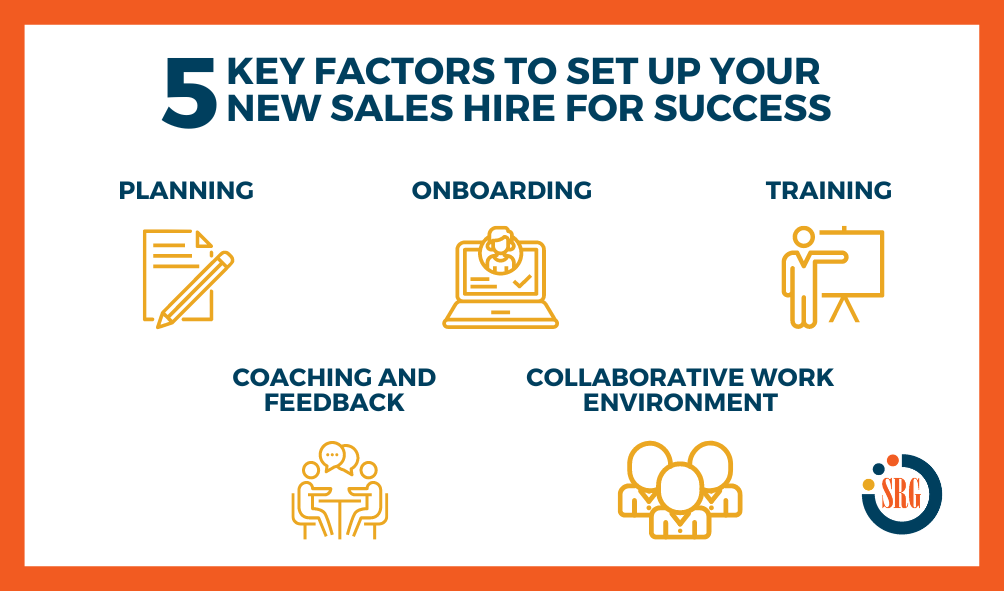Hiring and onboarding new sales hires can be extremely challenging especially for sales managers who lead, manage, and coach an existing sales team. Focus on these five factors to increase your odds of success with new sales hires.
The pressure to fill a new or vacant sales position can often lead to rushed hiring decisions that don’t work out. This can be both expensive and frustrating. In addition to losing the revenue you hoped to gain by filling the position, you’ve lost time and money recruiting, hiring, and onboarding this person. The wrong hire can also lead to damaged relationships with customers who now have to deal with yet another new salesperson.
While hiring is not an exact science, the following steps will greatly improve ramp-up times and increase your likelihood of success.

#1: Planning
Defining who you are looking for is essential. Unfortunately, many managers end up using the job description as the basis for selecting a new salesperson. While the job description includes qualification criteria like experience and technical skills, it does not include the specific selling skills and intangible qualities that are most closely aligned with success in your organization.
To assess what skills and personal qualities are most important in your organization, take a look at your top performers and think about what sets them apart from lower performers. Based on your job description and the information you have gathered, you can now create a job profile that better describes the type of candidate you are looking to hire.
It's also important to plan your interview process and prepare questions you want to ask candidates. From a process standpoint, consider starting with a 15-minute screening interview to assess general qualifications, communication skills, and interest level. Based on the phone screen, you can narrow your search to the top candidates you would like to interview in person.
In preparation for the in-person interview, develop "STAR (Situation, Tasks, Actions, and Results) questions" you can ask candidates to assess skill levels and personal qualities. This approach allows you to learn more about their qualifications for the position rather than be swayed by your first impression.
#2: Onboarding
Sales organizations are often eager to fill a position but fail to put in place the infrastructure to allow the new hire to be fully productive. A structured onboarding process allows your new salesperson to hit the ground running.
Here are key elements that should be in place when your new salesperson begins:
- Sales playbook for their review and reference
- Scheduled intro meetings with other members of the sales team
- Technology (hardware and software) set up
- Training plan
- Performance expectations for the first 30, 60, and 90 days
- Ongoing coaching and feedback
#3: Training
Think about training in broad categories all of which contribute to sales success for your new salesperson. This training can include:
- Company, industry, and competitive landscape
- Product/service offerings for target customers and competitive points of differentiation
- Technical such as hardware, software, and tech stack
- Selling skills, with an emphasis on skills that are most applicable during the first 90 days (e.g., prospecting if they are developing a new territory)
The training schedule can include participating in already scheduled group trainings, or individual training with other members of your sales organization.
#4: Ongoing Coaching and Feedback
Coaching is a highly effective way to complement and apply training skills. Managers can join salespeople for calls, debrief with them afterward, and help prepare them for upcoming calls. Initially, your coaching may focus more on skill development, but as opportunities start entering the pipeline, coaching can shift to weekly deal coaching. This should include discussing new opportunities and developing strategies to advance existing opportunities.
As the manager, you should also provide feedback so that you can reinforce what your new salesperson is doing well and help them course correct where you identify performance gaps. Keep in mind that you should have already provided clear performance expectations for the first 30, 60, and 90 days so it is important to assess whether your new salesperson is on track to meet or exceed those expectations.
While it is easy to deliver positive feedback, it is essential that you also discuss areas for improvement if there are deficiencies. Your advice should be offered in a direct and constructive manner, and you should provide additional coaching as needed. Role-plays are a great way to promote skill development and should be incorporated into your coaching to address any skill gaps you’ve identified.
#5: Collaborative Work Environment
Most sales organizations are now functioning remotely, which makes it even harder to connect and collaborate with colleagues. New hires often feel disconnected and unsupported when their manager and peers are preoccupied with their clients and sales opportunities.
To address this issue, it is essential to establish a cadence for manager check-in calls, one-on-one meetings, and sales team meetings. Here's an example:
| Meeting |
Length |
Frequency |
| Check-In |
5 - 10 Minutes |
Daily during the first two weeks, and then as needed. |
| One-On-One |
60 Minutes |
Weekly |
| Entire Team |
60 Minutes |
Weekly |
Key Takeaways
To successfully hire and onboard a new salesperson you should:
- Develop a job profile with the skills, experience, and qualities you are looking for
- Take the time to screen applicants and conduct in-depth interviews with top candidates
- Establish an onboarding and training plan
- Provide ongoing coaching and feedback
- Create and promote a collaborative work environment
By focusing on these key factors, you can greatly increase the ramp-up time and success rate for your new sales hires.
If you want to help your Sales Managers hire, onboard, train and coach successful sales stars, you might be interested in our High-Impact Sales Manager program. With this skills-based training, sales managers learn a complete framework and practical tools to improve how they manage performance to drive sales results. Take the first step towards creating a high-performance sales culture for your team today!

